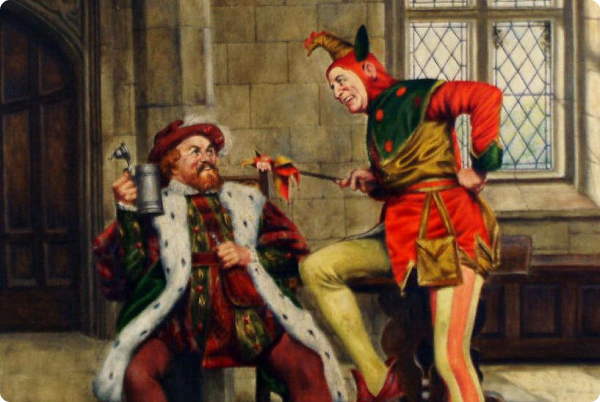Fables and Tales
Jesters have always been tricksters, and throughout myths and literature, they are known to be troublemakers, and often get out of sticky situations with their sharp wit.
Fables About the Jester
In many fables told to children over the decades, the jester has been a character that always was quick to outwit their opponents and use their special skill set to save the day.
Aesop’s Fables
One of the most famous fables about a jester can be found in Aesop’s fables. Aesop’s fables are a collection of stories from the Greek storyteller from around 620 BCE. Some of Aesop’s most famous fables include ‘The Boy Who Cried Wolf’ and ‘The Hare and The Tortoise’.
In his fable about ‘The Village Jester’ he tells the tale of a village man who wanted to play a trick on his friends. The man claimed that he had a wheel carriage that did not need to be pulled by horses, the villagers were disbelieving, but nonetheless very curious to see the carriage. When it came time for the man to show the carriage, he appeared with a wheelbarrow in tow. The villagers were not pleased that they had all fallen for the simple trick, and this fable teaches the lesson to always use your common sense.
The Clever Jester
Another fable based on the clever Nicolas Ferrial (1479-1536) also known as Triboulet, a jester to the French court. For this court jester, his wit and humour would save his life.
The court jester in this tale was known to be a trickster and make fun of the King. However, one day the jester went too far and insulted the King. The King was furious and demanded that the jester be thrown in jail. The jester was sentenced to death for the insult to the King, but feeling compassionate, the King asked the jester which way he would prefer to die.
The clever jester responded with, “Your Majesty, I choose to die of old age”. The King laughed and granted the jesters’ wish, he would not be sentenced to die. Thus, the jester outwitted the King and avoided his untimely death.
Learn more about how famous jesters left their mark throughout history.
The Jester and the Laughing Bird
This is a fable about a jester named Trumbelo in King Arthur’s court. This court jester was eager to prove himself and wished to become a knight. Unfortunately, King Arthur did not trust the jester with their missions, instead he sent the fool on a fake quest. All the jester had to do was find an ‘invisible princess guarded by an invisible dragon’ and save her.
So the jester set out to search for the princess, he searched for days before he gave up. He was sitting in a forest when he heard laughter and saw a Chaffinch perched in a tree. The jester became so angry with the bird’s taunting chirps that he chased after him, waving his sceptre in fury. The jester chased the bird through the forest and into a cave, running round and round in circles.
Unbeknownst to the jester, inside the cave was a woman trapped in stone and turned into a statue. Seeing the jester chase the bird and waving his sceptre, her stony features transformed, and she began to laugh. The jester was shocked to see the statue’s spell broken and the woman explained, “So many knights have tried and failed to free me, but with laughter you have set me free.”
Learn more about jesters around the world and their colourful stories throughout history.
Throughout literature, there are countless examples of the jester archetype. Thanks to their impact on history and their colourful dispositions, they have inspired many authors across the ages.
If you are looking for a portrayal of jesters, you can read about them in the series by DE King. The Series ‘In All Jest’ begins with A Fool’s Errand, and dives into a secret society of jesters.
In this series you follow the lives of the jesters who are responsible for maintaining stability in Dharatan. A powerful amulet surfaces after 800 years and a jester steals it before it falls into dangerous hands, setting off a chain of events that will change the way their world is forever.


Medieval Jester | A.L. Grace (19th Cent.)
The tales of fools were not just limited to the Middle Ages, there are examples of both licensed and natural fools dating from the ancient age well into modern time.
Over the ages, some historical accounts of famous jesters have morphed into myths and legends, telling tales of the witty court jesters and their feats.
Such is the case some Chinese Jesters, including Dongfang Shuo (東方朔). Dongfang was a jester during the Han Dynasty, and stories of his life over time have created the myth that he was an immortal spirit and a god of gold and storytellers. His tale includes his journey to a sacred garden of a Chinese goddess and stealing the peaches of longevity.
The Archetype of the Jester
The representation of the jester is a common archetype used in both theatre and books. In any portrayal of the jester there is the use of humour, whether intentional or unintentional, that the character is based around. These characters not only provide some comedic relief, but they are also tools of truth, and can help other characters come to terms with revelations or help motivate and move the plot forward.
Jesters can vary in appearance and genre as an archetype, but they will often have key personality traits, including charisma, an impulsive nature, a sharp wit, and mischievous nature.
The Shakespearean Fool
Shakespeare also used the archetype of the jester in many of his plays. Examples of his fools include Feste from Twelfth Night, Touchstone from As You Like It, Trinculo from The Tempest, and The Fool from King Lear.
The famous line from King Lear in which the fool says, “Truth’s a dog must to kennel; he must be whipped out, when Lady the brach may stand by the fire and stink.” This is the perfect example of both the mischievous nature and wit of the fool. While he doesn’t speak plainly and uses riddles to confuse the other characters, his words are also weighted with wisdom, much like the court jesters of history.


